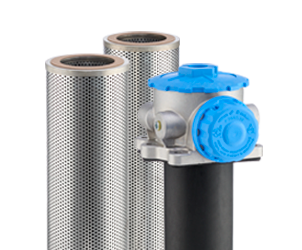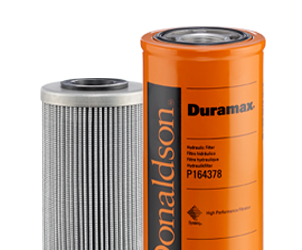From the mighty excavator to the skid-steer loader, no hydraulic system can function without its lifeblood: hydraulic fluid. But have you ever wondered, exactly what is hydraulic fluid? In this article, we look at hydraulic fluid and all things related, including hydraulic contamination, hydraulic flushing, hydraulic filter types and what you should do if you’re unfortunate enough to experience hydraulic fluid injection.
1. What is hydraulic fluid?
A hydraulic system uses a fluid (instead of rigid components) as a flexible medium to do work around the system. But that’s not all that hydraulic fluid does: it also provides essential lubrication, reducing friction and abrasion; and it conducts heat away from critical components, improving performance and extending the life expectancy of your equipment. The brake fluid and power steering fluid in our vehicles are the examples of hydraulic fluids that we are most familiar with.
2. What are the different types of hydraulic fluid?
There are hydraulic fluid types to suit every situation. So, what hydraulic fluid should you use? Depending on the system, you might want a water-based or a petroleum-based fluid; it can be natural/bio or synthetic; some specialized types are even flame-retardant! Agricultural machinery may often use biodegradable hydraulic fluid, while heavy equipment tends to use synthetic, petroleum-based products. No matter what hydraulic fluid you use, make sure to stay consistent and don’t top off with a different manufacturer’s product. It is also important that you sample your hydraulic fluid routinely for water and contamination. Follow the manufacturer’s recommendations for hydraulic fluid properties.
3. How does hydraulic contamination happen?
Hydraulic fluid contamination is arguably the Achilles’ heel of any hydraulic system. 70-80% of hydraulic systems failures are attributable to contaminants in the fluid. And typically with equipment, higher pressures and tighter tolerances leave the system more susceptible to contamination and debris. This can mean costly repairs and replacements, impacting the return on your investment.
- Contamination by air- and water-borne particles can severely impact your equipment’s cycle time and performance, resulting in loss of power and reduced heat dissipation. Milky-looking hydraulic fluid is typically indicative of water contamination; foamy fluid is most likely contaminated by air.
- Particulate contamination is responsible for much of the visible damage to final drives and hydraulic motors. Sand, silt, dust, and soot typically reach your hydraulic system through leaky seals or lack of breather filtration. If fluids can get out, dirt can get in: never risk ignoring a leak, no matter how small! As a general rule, if you replace a hose, you should also replace your filtration and replace or flush the hydraulic fluid.
- Chemical contamination arises when aging hydraulic fluid begins to degrade (oxidize) and break down. It can also happen if different hydraulic fluid types are mixed: incompatible additives may have unwanted chemical reactions. Chemical contamination is a primary reason to change your hydraulic fluid regularly. Check the manufacturer’s guidelines for what hydraulic fluid you’re using: the guidelines will recommend an optimal schedule for changing out the specific fluid you’re using.
Unfortunately, some contamination is inevitable, whether it’s the built-in or generated contamination produced during system operation, or unwanted external contaminants entering the system. Fortunately, you can minimize hydraulic fluid contamination by using quality filters, such as those produced by Donaldson, and by performing regular flushing.
4. How can hydraulic filters help?
Using and maintaining a good quality hydraulic filter is one of the key ways to tackle the problem of contamination, keeping every component performing at its best, and ultimately extending the working life of your system as a whole. Spending your money on quality filters is always a wise investment. Donaldson has been producing high quality filtration products and solutions for more than 100 years – filtration technology is in our DNA.
There are different types of hydraulic filters to suit different uses and hydraulic fluid types, and Donaldson produces options for low, medium and high-pressure applications. For example, a case drain filter protects against excess pressure building up in your case drain line. If the pressure gets too high, seals will start to give, and you could even see the cover blown off your motor!
Off-line filtration can supplement your core system filtration. Donaldson’s Filter Cart, Filter Panel and Filter Buddy offer convenient off-line filtration, flushing and fluid transfer. These can be used with industrial and mobile equipment.
Replacing conventional desiccant breathers with Donaldson’s T.R.A.P. (Thermally Reactive Advanced Protection) breathers will protect against both airborne moisture and particulate contamination. T.R.A.P technology strips moisture vapor from intake air and expels the moisture back to the atmosphere. Not only that, but the T.R.A.P. breathers offer 3 times the dirt-holding capacity of conventional desiccant breathers.
5. How do I know if I should flush or change my hydraulic fluid?
Flushing your hydraulic fluid does not mean simply changing it out. Flushing your hydraulic fluid is a much more involved task and is recommended whenever a component has failed (for example, a final drive or a pump), or if a critical component, or a whole machine, has been rebuilt. It involves first draining the hydraulic fluid, then running a fluid with a lower viscosity through the system under high pressure. This dislodges any dirt and debris from the system, leaving it clean and ready for you to introduce fresh hydraulic fluid. In short: best practice is to change your fluid regularly, and to flush it when necessary.
6. What is hydraulic fluid injection?
When hydraulic fluid is under pressure, the force can be strong enough to penetrate your skin. This is known as hydraulic fluid injection, the results of which can be severe, and in some cases fatal. Because the injury can feel minor, like a bee sting or jabbing yourself with a pin, it often goes unnoticed and ignored. If you’re checking for fluid leaks, never just feel around with your bare hands – instead, use a clean, dry piece of cardboard or another material to assess the area. If you are unfortunate enough to be stung/stabbed and suspect an injection injury, play it safe: seek medical attention! The injury might seem insignificant; but the potential consequences are not!
Now you know about hydraulic fluid.
We’ve looked at the different hydraulic fluid types, how contamination happens, and what to do about it, including a look at different types of hydraulic filters. The importance of hydraulic fluid cannot be underestimated. And if you’re investing money in the right fluid, it’s well worth spending time, effort, and money on keeping it in the best possible condition. Check the condition of your filters regularly and change them when they become contaminated or damaged. Change each type of hydraulic fluid in line with manufacturer guidelines and perform flushing when warranted. Your hydraulic systems will thank you and reward your investment with extended years of performance.

Hydraulic Fluid Contamination
Hydraulic fluid contamination causes most hydraulic system failures, resulting in costly repairs and replacements. Learn how contamination-free fluids can improve system performance and extend component life.





